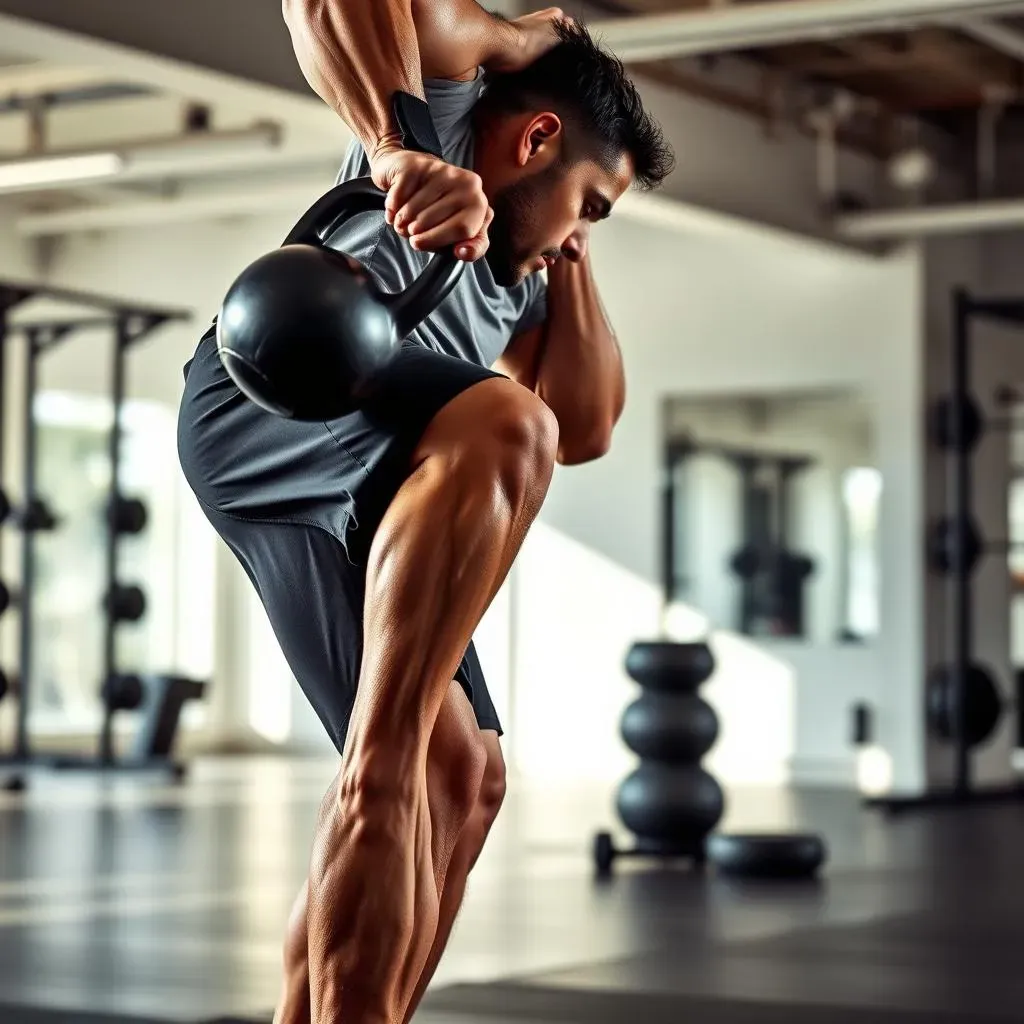Table of Contents
Ready to torch calories, build serious muscle, and feel amazing? You've landed in the right spot! This isn't just another workout – it's your guide to the best full body kettlebell workout. Kettlebells are the ultimate tool for sculpting a strong, lean physique, improving your cardio, and boosting your overall fitness. Forget endless hours at the gym; with just one kettlebell, you can unlock a full-body transformation.
Kettlebell Basics: Choosing the Right Weight and Mastering Form

Kettlebell Basics: Choosing the Right Weight and Mastering Form
Alright, so you're ready to dive into the world of kettlebells? Awesome! But before you start swinging like a pro, let's nail down the fundamentals: choosing the right weight and mastering proper form. This is where many beginners stumble, but trust me, getting this right from the start will save you from injuries and set you up for long-term success. Think of it like building a house – you need a solid foundation before you can start adding the fancy stuff.
First up, let's talk weight. It's tempting to grab the heaviest kettlebell you can find, especially if you're already lifting weights. But kettlebells are different. The off-center load and dynamic movements require a whole new level of control. Start too heavy, and you'll be sacrificing form, which is a recipe for disaster. For women, I generally recommend starting with an 8kg (18lb) or 12kg (26lb) kettlebell. For men, a 12kg (26lb) or 16kg (35lb) is usually a good starting point. If you're unsure, always err on the side of caution and go lighter. You can always increase the weight later as you get stronger and more comfortable with the movements.
Now, let's move on to the REALLY important stuff: form. Seriously, I can't stress this enough. Good form isn't just about looking pretty; it's about protecting your joints, engaging the right muscles, and maximizing the effectiveness of each exercise. I know, I know, it sounds boring, but trust me, it's worth it. The kettlebell swing, for example, is a foundational movement, but it's also one of the most commonly butchered. People often turn it into a squat, using their arms to lift the weight. But a proper swing is all about the hip hinge – think of it as snapping your hips forward to propel the kettlebell up. Your arms should just be along for the ride.
Movement | Key Form Points |
|---|---|
Kettlebell Swing | Hip hinge, engage glutes and core, keep back straight. |
Goblet Squat | Hold kettlebell close to chest, maintain upright posture, squat deep. |
Turkish Get-Up | Break down the movement into small steps, maintain focus, control the descent. |
Take the time to learn the proper technique for each exercise. Watch videos, read articles, and even consider working with a qualified kettlebell instructor. Pay attention to how your body feels. Are you feeling the movement in the right muscles? Are you experiencing any pain? If something doesn't feel right, stop and reassess your form. Don't be afraid to start slow and gradually increase the intensity as you improve. Remember, it's a marathon, not a sprint. By prioritizing proper form and choosing the right weight, you'll be well on your way to unlocking the incredible benefits of kettlebell training.
The Ultimate Full Body Kettlebell Workout: Exercises and Routine

The Ultimate Full Body Kettlebell Workout: Exercises and Routine
Kettlebell Swing Domination
Alright, let's get into the nitty-gritty of the ultimate full body kettlebell workout! And where better to start than with the king of kettlebell exercises: the swing. This move isn't just a great way to blast your hamstrings and glutes; it's also a fantastic cardio exercise and a killer core strengthener. I always tell people, if you only have time for one kettlebell exercise, make it the swing. It's that good.
The key to a perfect swing is the hip hinge. Remember, you're not squatting – you're hinging at the hips, pushing your butt back like you're closing a car door with your backside. Keep your back straight, engage your core, and snap your hips forward to propel the kettlebell up. Let the kettlebell float at the top of the swing, then guide it back down between your legs, maintaining control throughout the entire movement. Aim for 3 sets of 15-20 reps, focusing on power and technique.
Squatting for Strength: Goblet Squats and Front Squats
Next up, let's talk squats. Squats are a fundamental exercise for building lower body strength and power, and kettlebells take them to a whole new level. The goblet squat is a great variation for beginners, as it helps to improve posture and balance. Simply hold the kettlebell close to your chest, keep your core engaged, and squat down as deep as you can while maintaining good form. For a more advanced challenge, try front squats, holding the kettlebells in the front rack position. This variation will fire up your quads and core like never before.
When squatting, remember to keep your chest up, your back straight, and your knees tracking over your toes. Don't let your knees cave in or your back round. Aim for 3 sets of 10-12 reps for each variation. If you're new to squats, start with bodyweight squats to master the form before adding the kettlebell. Also, don't be afraid to use a mirror or record yourself to check your technique.
Exercise | Sets | Reps | Focus |
|---|---|---|---|
Kettlebell Swing | 3 | 15-20 | Power, hip hinge |
Goblet Squat | 3 | 10-12 | Posture, balance |
Kettlebell Front Squat | 3 | 10-12 | Quads, core |
Total Body Domination: Presses, Rows, and Get-Ups
To round out the ultimate full body kettlebell workout, we need to incorporate some upper body exercises. Kettlebell presses are a fantastic way to build shoulder strength and stability. You can do them standing or kneeling, and you can use a single kettlebell or two. Rows are another essential exercise, targeting your back and biceps. Kettlebell rows can be done in a variety of ways, including bent-over rows, renegade rows, and single-arm rows.
And finally, no full body kettlebell workout would be complete without the Turkish get-up. This exercise is a true test of strength, coordination, and mental toughness. It involves transitioning from lying on the ground to standing up while holding a kettlebell overhead. It's a complex movement, but it's incredibly rewarding and will challenge you in ways you never thought possible. Aim for 3 sets of 8-10 reps per side for presses and rows, and 3-5 reps per side for Turkish get-ups. Remember to focus on quality over quantity, and don't be afraid to break down the movements into smaller steps.
Targeting Every Muscle: Benefits of a Full Body Kettlebell Workout

Targeting Every Muscle: Benefits of a Full Body Kettlebell Workout
Strength and Conditioning Synergy
let's talk about why a full body kettlebell workout is so darn effective. It's not just about lifting weights; it's about combining strength training and cardio into one seriously efficient package. Think about it: with each swing, squat, or press, you're not only building muscle but also getting your heart rate up and improving your cardiovascular fitness. It's like hitting two birds with one very well-aimed kettlebell!
What I love about kettlebells is that they force you to engage your entire body with every movement. Unlike isolation exercises that target specific muscles, kettlebell exercises are compound movements that work multiple muscle groups simultaneously. This means you're not only building strength but also improving your coordination, balance, and overall functional fitness. It's the kind of training that translates to real-life strength and makes everyday activities easier and more enjoyable.
More Than Just Muscles: A Holistic Approach
But the benefits of a full body kettlebell workout go far beyond just building muscle and burning calories. Kettlebell training can also have a profound impact on your mental and emotional well-being. The focus and concentration required to perform kettlebell exercises can help to reduce stress and improve focus. And the feeling of accomplishment you get after completing a challenging workout can boost your mood and self-confidence.
Plus, kettlebell training is incredibly versatile and adaptable. You can do it anywhere, anytime, with just one piece of equipment. This makes it a great option for people who are short on time or who travel frequently. And because kettlebell exercises can be modified to suit any fitness level, it's a great option for people of all ages and abilities. Whether you're a seasoned athlete or a complete beginner, a full body kettlebell workout can help you achieve your fitness goals and transform your life.
Benefit | Description |
|---|---|
Full-Body Engagement | Works multiple muscle groups simultaneously for efficient training. |
Cardio and Strength Combo | Improves cardiovascular fitness while building muscle strength. |
Improved Balance and Coordination | Enhances overall functional fitness for real-life activities. |
Mental and Emotional Well-being | Reduces stress, improves focus, and boosts self-confidence. |
Kettlebell Workout Safety: Avoiding Injuries and Common Mistakes

Kettlebell Workout Safety: Avoiding Injuries and Common Mistakes
Listen to Your Body and Warm-Up
Alright, let's get real about kettlebell workout safety. I'm all about pushing your limits, but not at the expense of your body. The number one rule? Listen to your body! If something feels off, don't push through it. Pain is your body's way of saying, "Hey, something's not right!" So, back off, reassess your form, and if the pain persists, stop and seek professional advice. It's way better to take a day or two off than to end up with a serious injury that sidelines you for weeks or months.
And speaking of preparation, never skip your warm-up! A proper warm-up gets your blood flowing, loosens up your joints, and prepares your muscles for the workout ahead. I like to start with some light cardio, like jogging in place or jumping jacks, followed by dynamic stretches like arm circles, leg swings, and torso twists. Spend at least 5-10 minutes warming up before you even think about picking up a kettlebell. Trust me, your body will thank you.
Master the Fundamentals and Avoid Common Pitfalls
Another key aspect of kettlebell workout safety is mastering the fundamentals before progressing to more advanced exercises. Don't try to run before you can walk. Start with the basic movements, like the swing, goblet squat, and deadlift, and focus on perfecting your form. Once you've got those down, you can gradually introduce more challenging exercises, like the snatch and Turkish get-up. But even then, always prioritize proper technique over lifting heavy weight. Remember, it's not about how much you can lift; it's about how well you can lift it.
And finally, be aware of common kettlebell mistakes. One of the biggest is using your arms to lift the weight instead of engaging your hips and core. This puts unnecessary stress on your shoulders and back and can lead to injuries. Another mistake is rounding your back, especially during exercises like the swing and deadlift. This puts you at risk of disc herniation and other spinal problems. So, keep your back straight, engage your core, and lift with your legs and hips. If you're unsure about your form, don't hesitate to ask a qualified kettlebell instructor for guidance.
Safety Tip | Description |
|---|---|
Listen to Your Body | Stop if you feel pain and seek professional advice. |
Warm-Up Properly | Prepare your body with light cardio and dynamic stretches. |
Master the Fundamentals | Perfect basic movements before progressing to advanced exercises. |
Avoid Common Mistakes | Engage your hips and core, keep your back straight, and seek guidance. |
Beyond the Basics: Advanced Kettlebell Exercises for a Full Body Challenge

Beyond the Basics: Advanced Kettlebell Exercises for a Full Body Challenge
Unlocking New Potential
So, you've mastered the basics of kettlebell training? Awesome! Now it's time to crank things up a notch with some advanced exercises that will challenge your strength, coordination, and mental toughness. This is where the real fun begins, where you'll discover just how versatile and effective kettlebells can be. But remember, these exercises are not for the faint of heart. They require a solid foundation of strength and technique, so make sure you're ready before you dive in. I always tell people, "Earn the right to progress."
One of my favorite advanced kettlebell exercises is the snatch. This is a full-body movement that involves lifting the kettlebell from the ground to an overhead position in one fluid motion. It's a true test of power, speed, and coordination. The clean and jerk is another great option, combining a clean (lifting the kettlebell to the front rack position) with a jerk (pressing the kettlebell overhead). This exercise will build serious strength in your legs, shoulders, and core.
Pushing Your Limits Safely
Another advanced exercise that I love is the Turkish get-up (TGU). Yes, we mentioned it earlier, but mastering it is a journey, not a destination! The TGU is a complex movement that involves transitioning from lying on the ground to standing up while holding a kettlebell overhead. It's a fantastic exercise for improving stability, mobility, and core strength. But it also requires a lot of focus and control, so start slow and gradually increase the weight as you get more comfortable with the movement.
When performing advanced kettlebell exercises, it's crucial to prioritize safety. Always warm up properly before starting your workout, and focus on maintaining good form throughout the entire exercise. Don't be afraid to break down the movements into smaller steps, and don't try to lift too heavy too soon. If you're unsure about your technique, seek guidance from a qualified kettlebell instructor. Remember, it's better to progress slowly and safely than to end up with an injury that sets you back. The goal is to challenge yourself, not to break yourself.
Exercise | Benefits | Focus |
|---|---|---|
Kettlebell Snatch | Power, speed, coordination | Fluid motion, proper technique |
Clean and Jerk | Legs, shoulders, core strength | Explosiveness, stability |
Turkish Get-Up | Stability, mobility, core strength | Focus, control, gradual progression |
Your Kettlebell Journey: Building Strength and Confidence
You've now got the knowledge and tools to conquer the best full body kettlebell workout. Remember, consistency is key. Start slow, focus on proper form, and gradually increase the intensity as you get stronger. Embrace the challenge, celebrate your progress, and enjoy the incredible benefits that kettlebell training offers. With dedication and the right approach, you'll not only transform your physique but also unlock a newfound sense of strength, confidence, and overall well-being. Now go grab that kettlebell and get swinging!